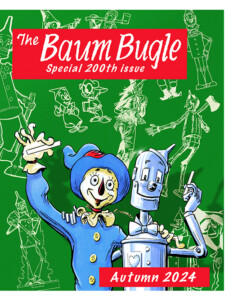
Vol. 68, no. 2 (Autumn 2024)
| Editor-in-Chief | Sarah K. Crotzer |
| Production Editor | Sarah K. Crotzer (uncredited) |
| Associate Editor | Nick Campbell |
| Bibliography Editor | Peter E. Hanff |
| Reviews Editor | Atticus Gannaway |
| News Editor | Zoe O’Haillin-Berne |
| Editorial Assistant | Christina Maffa |
Wraparound cover art by Mark Manley, homaging Dick Martin
Interior front cover art by Maxfield Parrish (cover of Metropolitan, Jan. 1917)
Interior back cover art by an unknown artist (Oz map from “Fairylogue and Radio-Plays”)
Autumn 2024 Selected Contents
This is a guide to the articles and reviews from the issue that will most benefit researchers, scholars, and collectors. The printed issue includes additional content such as news, editorial letters, and other commentary-based departments.
A Gleam in Justin’s Eye: Oz Club Origins
Founding member Ruth Berman recalls early correspondence with Ruth Plumly Thompson and Justin Schiller, and the creation of the “Wizard of Oz Fan Club,” opening this 200th issue of The Baum Bugle.
In Search of Snow White
Scott Cummings uncovers the mystery surrounding a theatrical adaptation of “Snow White” which would have been written by L. Frank Baum, with sets by legendary artist Maxfield Parrish.
Martin’s Marvels
Peter E. Hanff turns back the clock to look at early Bugle covers by Dick Martin, their development, and the printing processes used in their creation. Includes a full checklist of Dick’s cover art and a special, eight-page color section, primarily showing his work (including color separations for the Autumn 1965 cover, and separations by Bill Eubank for Winter 1977).
The Inspiring Maps of Oz
J. L. Bell shows how Baum’s map in Tik-Tok of Oz provides clues and inspirations for the locales of his remaining Oz books.
Keepers of the Record
Former Bugle editors-in-chief Bill Thompson, Michael Gessel, and John Fricke recall their time with the journal as we wrap up our special celebratory issue.
How it Began (Again)
Examples of the “dummy” created for the Spring 1979 Bugle give a valuable insight into Dick Martin’s way of creating the magazine for almost two decades.